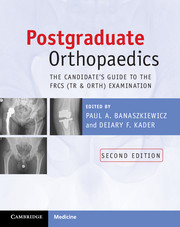Book contents
- Frontmatter
- Contents
- Contributors
- Foreword
- Preface to second edition
- Abbreviations
- Section 1 The FRCS (Tr & Orth) examination
- Section 2 The written paper
- Section 3 The clinicals
- Chapter 3 The short cases
- Chapter 4 The intermediate cases
- Chapter 5 Shoulder and elbow clinical cases
- Chapter 6 Hand and wrist clinical cases
- Chapter 7 Spine clinical cases
- Chapter 8 Hip clinical cases
- Chapter 9 Knee clinical cases
- Chapter 10 Foot and ankle clinical cases
- Chapter 11 Paediatric clinical cases
- Section 4 The adult elective orthopaedics oral
- Section 5 The hand oral
- Section 6 The paediatric oral
- Section 7 The trauma oral
- Section 8 The basic science oral
- Section 9 Miscellaneous topics
- Index
- References
Chapter 10 - Foot and ankle clinical cases
from Section 3 - The clinicals
- Frontmatter
- Contents
- Contributors
- Foreword
- Preface to second edition
- Abbreviations
- Section 1 The FRCS (Tr & Orth) examination
- Section 2 The written paper
- Section 3 The clinicals
- Chapter 3 The short cases
- Chapter 4 The intermediate cases
- Chapter 5 Shoulder and elbow clinical cases
- Chapter 6 Hand and wrist clinical cases
- Chapter 7 Spine clinical cases
- Chapter 8 Hip clinical cases
- Chapter 9 Knee clinical cases
- Chapter 10 Foot and ankle clinical cases
- Chapter 11 Paediatric clinical cases
- Section 4 The adult elective orthopaedics oral
- Section 5 The hand oral
- Section 6 The paediatric oral
- Section 7 The trauma oral
- Section 8 The basic science oral
- Section 9 Miscellaneous topics
- Index
- References
Summary
Equinus
The majority of weight is borne by the forefoot, the hindfoot remaining off the ground. The equinus deformity may be compensatory for either quadriceps or gluteus maximus weakness, or because of shortening of the limb. The equinus deformity may also be caused by contracture of gastrocnemius, ankle contracture or post traumatic defornity.
Calcaneus
Here the weight is borne mainly by the hindfoot. The forefoot may have varying degrees of weightbearing, but definitely below normal.
- Type
- Chapter
- Information
- Postgraduate OrthopaedicsThe Candidate's Guide to the FRCS (Tr and Orth) Examination, pp. 111 - 126Publisher: Cambridge University PressPrint publication year: 2012



